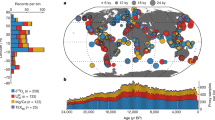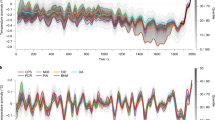Abstract
Regional climate change can arise from three different effects: regional changes to the amount of radiative heating that reaches the Earth’s surface, an inhomogeneous response to globally uniform changes in radiative heating and variability without a specific forcing. The relative importance of these effects is not clear, particularly because neither the response to regional forcings nor the regional forcings themselves are well known for the twentieth century. Here we investigate the sensitivity of regional climate to changes in carbon dioxide, black carbon aerosols, sulphate aerosols and ozone in the tropics, mid-latitudes and polar regions, using a coupled ocean–atmosphere model. We find that mid- and high-latitude climate is quite sensitive to the location of the forcing. Using these relationships between forcing and response along with observations of twentieth century climate change, we reconstruct radiative forcing from aerosols in space and time. Our reconstructions broadly agree with historical emissions estimates, and can explain the differences between observed changes in Arctic temperatures and expectations from non-aerosol forcings plus unforced variability. We conclude that decreasing concentrations of sulphate aerosols and increasing concentrations of black carbon have substantially contributed to rapid Arctic warming during the past three decades.
This is a preview of subscription content, access via your institution
Access options
Subscribe to this journal
Receive 12 print issues and online access
$259.00 per year
only $21.58 per issue
Buy this article
- Purchase on Springer Link
- Instant access to full article PDF
Prices may be subject to local taxes which are calculated during checkout



Similar content being viewed by others
References
Boer, G. & Yu, B. Climate sensitivity and response. Clim. Dyn. 20, 415–429 (2003).
Hansen, J. et al. Efficacy of climate forcings. J. Geophys. Res. 110, D18104 (2005).
Mitchell, J. F. B., Davis, R. A., Ingram, W. J. & Senior, C. A. On surface temperature, greenhouse gases, and aerosols: Models and observations. J. Clim. 8, 2364–2386 (1995).
Shindell, D. T. et al. Multi-model projections of climate change from short-lived emissions due to human activities. J. Geophys. Res. 113, D11109 (2008).
Andronova, N. G. & Schlesinger, M. E. Objective estimation of the probability density function for climate sensitivity. J. Geophys. Res. 106, 22605–22611 (2001).
Santer, B. D. et al. A search for human influences on the thermal structure of the atmosphere. Nature 382, 39–46 (1996).
Stott, P. A. et al. Observational constraints on past attributable warming and predictions of future global warming. J. Clim. 19, 3055–3069 (2006).
Schulz, M. et al. Radiative forcing by aerosols as derived from the AeroCom present-day and pre-industrial simulations. Atmos. Chem. Phys. 6, 5225–5246 (2006).
Bellouin, N., Boucher, O., Haywood, J. & Reddy, M. S. Global estimate of aerosol direct radiative forcing from satellite measurements. Nature 438, 1138–1141 (2005).
Chung, C. E., Ramanathan, V., Kim, D. & Podgorny, I. A. Global anthropogenic aerosol direct forcing derived from satellite and ground-based observations. J. Geophys. Res. 110, D24207 (2005).
Mickley, L. J., Jacob, D. J. & Rind, D. Uncertainty in preindustrial abundance of tropospheric ozone: Implications for radiative forcing calculations. J. Geophys. Res. 106, 3389–3399 (2001).
Shindell, D. T. & Faluvegi, G. An exploration of ozone changes and their radiative forcing before the chlorofluorocarbon era. Atmos. Chem. Phys. 2, 363–374 (2002).
Forster, P. et al. in Climate Change 2007: The Physical Science Basis (eds Solomon, S. et al.) (Cambridge Univ. Press, 2007).
Penner, J. E. et al. Model intercomparison of indirect aerosol effects. Atmos. Chem. Phys. 6, 3391–3405 (2006).
Forster, P. M. d. F., Blackburn, M., Glover, R. & Shine, K. P. An examination of climate sensitivity for idealised climate change experiments in an intermediate general circulation model. Clim. Dyn. 16, 833–849 (2000).
Joshi, M. et al. A comparison of climate response to different radiative forcings in three general circulation models: Towards an improved metric of climate change. Clim. Dyn. 20, 843–854 (2003).
Smith, S. J., Pitcher, H. & Wigley, T. M. L. Global and regional anthropogenic sulfur dioxide emissions. Glob. Planet. Change 29, 99–119 (2001).
Bond, T. C. et al. Historical emissions of black and organic carbon aerosol from energy-related combustion, 1850–2000. Glob. Biogeochem. Cycles 21, GB2018 (2007).
Gultepe, I. & Isaac, G. A. Scale effects on averaging cloud droplet and aerosol number concentrations: Observations and models. J. Clim. 12, 1268–1279 (1999).
Philipona, R., Behrens, K. & Ruckstuhl, C. How declining aerosols and rising greenhouse gases forced rapid warming in Europe since the 1980s. Geophys. Res. Lett. 36, L02806 (2009).
Kaufmann, R. K. & Stern, D. I. Cointegration analysis of hemispheric temperature relations. J. Geophys. Res. 107, 4012 (2002).
Harvey, L. D. D. & Kaufmann, R. K. Simultaneously constraining climate sensitivity and aerosol radiative forcing. J. Clim. 15, 2837–2861 (2002).
Meehl, G. A. et al. in Climate Change 2007: The Physical Science Basis (eds Solomon, S. et al.) (Cambridge Univ. Press, 2007).
Quinn, P. K. et al. Short-lived pollutants in the Arctic: Their climate impact and possible mitigation strategies. Atmos. Chem. Phys. 8, 1723–1735 (2008).
Flanner, M. G., Zender, C. S., Randerson, J. T. & Rasch, P. J. Present-day climate forcing and response from black carbon in snow. J. Geophys. Res. 112, D11202 (2007).
Shindell, D. T. et al. The role of tropospheric ozone increases in 20th century climate change. J. Geophys. Res. 111, D08302 (2006).
Schlesinger, M. E. & Ramankutty, N. An oscillation in the global climate system of period 65–70 years. Nature 367, 723–726 (1994).
Johannessen, O. M. et al. Arctic climate change: Observed and modeled temperature and sea-ice variability. Tellus 56A, 328–341 (2004).
Bengtsson, L., Semenov, V. A. & Johannessen, O. M. The early twentieth-century warming in the Arctic—a possible mechanism. J. Clim. 17, 4045–4057 (2004).
Polyakov, I. V. et al. Observationally based assessment of polar amplification of global warming. Geophys. Res. Lett. 29, 1878 (2002).
Shindell, D. Local and remote contributions to Arctic warming. Geophys. Res. Lett. 34, L14704 (2007).
West, J. J., Fiore, A. M., Horowitz, L. W. & Mauzerall, D. L. Global health benefits of mitigating ozone pollution with methane emission controls. Proc. Natl Acad. Sci. 103, 3988–3993 (2006).
Schmidt, G. A. et al. Present day atmospheric simulations using GISS ModelE: Comparison to in-situ, satellite and reanalysis data. J. Clim. 19, 153–192 (2006).
Bowman, K. P. & Erukhimova, T. Comparison of global-scale Langrangian transport properties of the NCEP reanalysis and CCM3. J. Clim. 17, 1135–1146 (2004).
Klonecki, A. et al. Seasonal changes in the transport of pollutants into the Arctic troposphere-model study. J. Geophys. Res. 108, 8367 (2003).
Forster, P. M. & Taylor, K. E. Climate forcings and climate sensitivities diagnosed from coupled climate model integrations. J. Clim. 19, 6181–6194 (2006).
Lean, J. Evolution of the sun’s spectral irradiance since the Maunder Minimum. Geophys. Res. Lett. 27, 2425–2428 (2000).
Hansen, J. et al. Climate simulations for 1880–2003 with GISS modelE. Clim. Dyn. 29, 661–696 (2007).
Hansen, J. et al. A closer look at United States and global surface temperature change. J. Geophys. Res. 106, 23947–23963 (2001).
Rayner, N. A. et al. Global analyses of sea surface temperature, sea ice, and night marine air temperature since the late nineteenth century. J. Geophys. Res. 108, 10.1029/2002JD002670 (2003).
Acknowledgements
We thank NASA’s Atmospheric Chemistry Modeling and Analysis Program for support and R. Reudy and H. Teich for technical assistance. We acknowledge the modelling groups, the Program for Climate Model Diagnosis and Intercomparison and the Working Group on Coupled Modelling for making available the CMIP3 data set, which is supported by the Office of Science, US Department of Energy.
Author information
Authors and Affiliations
Contributions
D.S. conceived and designed the experiments and wrote the paper, G.F. carried out the model simulations and both analysed the data.
Corresponding author
Supplementary information
Supplementary Note
Supplementary Information (PDF 705 kb)
Rights and permissions
About this article
Cite this article
Shindell, D., Faluvegi, G. Climate response to regional radiative forcing during the twentieth century. Nature Geosci 2, 294–300 (2009). https://doi.org/10.1038/ngeo473
Received:
Accepted:
Published:
Issue Date:
DOI: https://doi.org/10.1038/ngeo473
This article is cited by
-
An emerging Asian aerosol dipole pattern reshapes the Asian summer monsoon and exacerbates northern hemisphere warming
npj Climate and Atmospheric Science (2023)
-
Sources, variability, long-term trends, and radiative forcing of aerosols in the Arctic: implications for Arctic amplification
Environmental Science and Pollution Research (2023)
-
Changes in organic matter properties and carbon chemical stability in surface soils associated with changing vegetation communities in permafrost peatlands
Biogeochemistry (2023)
-
Quantifying contributions of ozone changes to global and arctic warming during the second half of the twentieth century
Climate Dynamics (2023)
-
Sulfur emissions from consumption by developed and developing countries produce comparable climate impacts
Nature Geoscience (2022)




